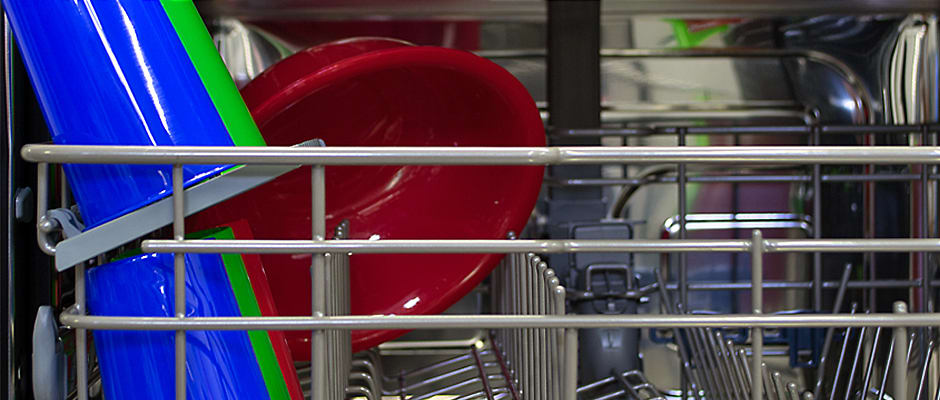Design & Usability
A clean look keeps it easy to use.
When it comes to streamlining the dishwashing experience, the DW7933LRASR has it all figured out. The control panel is simple and easy to use, with big, responsive buttons and bright blue indicator lights. It even has a progress indicator, telling you if your current load is washing, drying, or finished. The lack of a timer, as well as the fact that the whole panel is plastic, might turn some buyers away, but we can’t really fault its clean, uncluttered look.
{{vine 'hiQphYi1b2u'}}
Looking inside its stainless steel interior, the DW7933LRASR’s hard food disposer dominates the bottom of the tub. Instead of the detachable, fine-screen filtration system found in many other dishwashers, the hard food disposer grinds up dirt and drains it away. This saves you the trouble of having to remove and rinse a filter every so often.
The DW7933LRASR’s racks are very flexible, with many components that can be adjusted or removed entirely. You can detach the two mini cutlery baskets, the two rows of plate tines on the bottom rack, and the entire top rack if you need the extra room. We could comfortably fit 11 place settings and a serving setting inside the DW7933LRASR.
{{photo_gallery "Design Gallery"}}
Features
While sparse on extra features, it doesn't feel lacking.
With only four cycles and one additional wash option to choose from, the DW7933LRASR really targets the “set it and forget it” crowd. Each cycle can be selected at the press of a button, whether it’s Normal, Heavy, Quick+, or Smart Auto. Their names are self-explanatory, and for the most part, these four cycles should be enough to cover all your bases.
The only way to really customize a wash on the DW7933LRASR is by adding the Sanitize option. When engaged, it raises the final rinse temperature to bacteria-killing levels. There’s also a Child Lock feature, which we feel every dishwasher with a forward-facing control panel should have. There’s nothing complicated or fancy going on here, and that can be very appealing.
Performance
A clean look doesn't always mean clean dishes.
Until we hit the Start button, this dishwasher was a joy. Unfortunately, when we opened the door after the first round of stain tests, we found that the DW7933LRASR had a huge problem with redeposit. That's when dirt is washed off of one item but gets stuck to another instead of draining away. We can easily identify redeposit by loading dishes covered in baked-on spinach into the wash and seeing where the spinach ends up at the end of a run. In the case of the Normal wash, it ended up all over the items on the top rack. This was a real shame, because many of the original stains had been removed. In other words, the DW7933LRASR cleaned most of the dishes only to make them dirty again.
The Heavy cycle did a little better with the redeposit issue, and green spinach flakes weren't nearly as prevalent as they were after the Normal wash. However, for a cycle designed specifically to handle heavily stained pots and pans, it did a poor job with the burnt cheese and sugar we threw at it. Despite using the most water and electricity, as well as lasting the longest, the DW7933LRASR’s strongest cycle turned out to be rather wimpy.
If water and electricity usage is a big concern to you, we estimated an annual running cost is $33.95. That’s only a couple of dollars above the $32 average, but this dishwasher still doesn’t perform as well as others we’ve tested, such as the Bosch Integra Ascenta SHX3AR76UC.
For in-depth performance information, please visit the Science Page.
Conclusion
Simple is meaningless if it doesn't actually work.
Dishwashing should be simple and easy, and the DW7933LRASR’s design clearly points to that. There are definitely plenty of buyers who want to minimize their interactions with appliances, and this dishwasher is as low-maintenance as it gets. Unfortunately, if those people bought the DW7933LRASR, they might not end up with clean dishes.
Even at $699, we can’t really recommend this dishwasher. Flexible racks and a simple user interface are all pretty meaningless if your dishes don't get clean. You’ll find a better balance of price and performance with the Bosch Integra Ascenta SHX3AR76UC mentioned earlier, or with our Editors' Choice winner, the Frigidaire Gallery FGHD2465NF.
By the Numbers
The Samsung DW7933LRASR boasts a streamlined control panel and flexible racks, but our tests showed it to be pretty weak at cleaning. If we were to base our purchasing decisions on these numbers alone, we would not be able to justify spending $699 on this dishwasher.
Performance
The spinach migration would make a great documentary.
A recurring problem with the DW7933LRASR is redeposit. That's when dirt from one item gets washed off and then stuck to another. This happened with every cycle we tested. In the Normal cycle, many of the original stains were removed only to be replaced by spinach specks from other dishes. We were actually able to track the migration: we loaded the baked-on spinach on the bottom rack, and most of the spinach ended up on the top rack.
This happened on the Heavy cycle, as well, though not to the same extent. Again, dishes loaded on the bottom rack got only trace amounts of spinach sprayed onto them, while the green stuff was much more visible on the glasses and mugs loaded up top. The Heavy cycle also took hits with the burnt cheese and burnt sugar stains, clearing only 77% of the former and 80% of the latter. As the machine’s strongest cycle option, you’re out of luck if you need a way to deal with tough, baked-on stains.
Efficiency
We've had dishwashers that use less to do more.
Given the lackluster cleaning scores, we thought perhaps that the DW7933LRASR might not be using enough water or electricity for its cycles. Not so. The Normal cycle used 0.63 kWh of electricity and 4.8 gallons of hot water, which are both a little high for an everyday cycle. The Heavy cycle nearly doubles those numbers, using 1.11 kWh of energy and 9.22 gallons of water, while the Quick+ cycle—a fast cycle for lightly soiled items—used 0.70 kWh and 5.17 gallons of water.
The cycle durations weren’t bad, with Quick+ taking a little over one hour, Normal taking close to two, and Heavy taking nearly three. This still left us wondering why the cleaning scores were so low. The only conclusion we could draw is that the DW7933LRASR is squandering its available resources—the very definition of inefficiency. We estimated an annual running cost of $33.95, which is only a few dollars more than average, but more efficient dishwashers (like the Bosch Integra Ascenta SHX3AR76UC) do a better job cleaning.
Capacity
Plenty of space and adjustability.
This dishwasher has a flexible interior: two removable mini cutlery baskets, a removable top rack, and removable plate supports on the bottom rack mean you can make the most out of the space inside no matter how tall or oddly-shaped your dishware happens to be. We were able to comfortably fit 11 place settings and one serving setting inside the DW7933LRASR.
{{photo_gallery "Capacity Gallery"}}
Meet the tester
Johnny Yu is a former news and review writer for Reviewed.
Checking our work.
Our team is here to help you buy the best stuff and love what you own. Our writers, editors, and experts obsess over the products we cover to make sure you're confident and satisfied. Have a different opinion about something we recommend? Email us and we'll compare notes.
Shoot us an email

